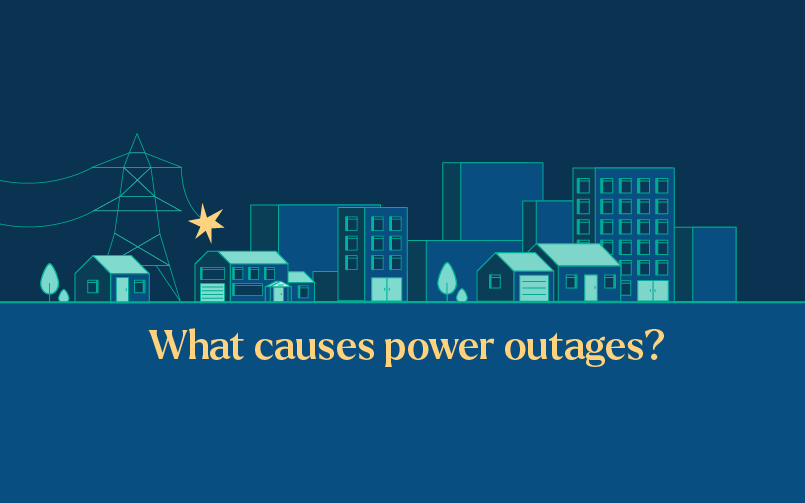When the power goes out, it can affect anywhere from a few blocks to entire neighborhoods and cities. These random power outages often happen without warning and can last hours or days. There are several reasons that power outages occur. These include natural disasters, car accidents, equipment failure, and weather-related issues.
Equipment Failure
Severe weather, such as lightning strikes, tornadoes and blizzards, is the top cause of power outages. These storms can damage the electric grid, and when they hit distribution lines (the wires that bring electricity to your house from the pole), the result is a widespread outage. Distribution line outages usually affect a smaller area than transmission line outages and may last longer. Faulty equipment is one of the causes of a power outage. Insufficient maintenance and mistakes during construction or operation can lead to equipment failure. This is particularly true of older equipment. Faulty underground cables and transformers can cause outages, as can overheating and short circuits. Another cause of power outages is the human factor. Drivers often collide with utility poles, particularly in areas with bad winter driving conditions. This can down the bar and disrupt the flow of electricity.
In addition, vandals and thieves can damage or steal equipment from power stations and substations. The high price of metals has encouraged scavengers to enter and break into these facilities, and snakes are particularly adept at entering substations and damaging or stealing equipment. A supply shortage is also a common cause of power outages. This can happen when the electricity demand exceeds the available supply, which is common on hot days when everyone blasts their air conditioners simultaneously. To deal with this, utilities may initiate rolling blackouts where they shut off power to a small number of customers at a time to lower demand and avoid outages.
Natural Disasters
Power outages can happen anywhere along the electricity production, distribution, and delivery chain. First, a power plant generates electricity; then, high-voltage transmission lines move that energy over long distances to the local distribution network. Once there, a myriad of problems can interrupt the flow of electricity to your home. Natural disasters account for some of the largest power outages in history and can wreak havoc on entire regions. Hurricanes, storms, and other weather-related natural disasters can destroy critical power infrastructure and knock out service for millions of people. Trees can also be at the root of many power outages, whether from a storm blowing branches into wires or an untrained tree-trimming company cutting down limbs too close to electrical lines. Heavy snow and ice can also weigh down tree limbs and utility poles, causing them to fall.
Finally, wildlife can cause power outages by tripping circuit breakers or damaging equipment. Birds, squirrels, and other animals have been known to climb on transformers or other utility equipment in search of food or to build nests that can short-circuit connections. They are also a common problem for substations, where they can enter for warmth or the hum of flowing electricity and cause a short circuit. Utility companies are increasingly using technology and other strategies to deter these animals.
Car Accidents
Power outages are most likely in areas with a large population and a grid serving a wide geographical area. That’s because these regions are a lot more complex and prone to accidents or human error that shut off the flow of electricity. Vehicle accidents are one of the top causes of power outages because vehicles can crash into utility poles and other objects associated with electricity distribution. These include angle collisions, which cause the highest number of deaths and injuries, and head-on and side collisions. Many power outages caused by car accidents are preventable. For example, people digging in the wrong place often cut underground cables. This can be prevented by calling a national hotline before starting any digging project. Trucks and other construction equipment often contact overhead lines when misjudging their size. This can also be prevented by contacting the utility company before starting a job requiring lifting or moving heavy materials. Small animals are sometimes responsible for power outages as well. Squirrels, rodents and raccoons are known for climbing onto equipment like transformers and fuses, creating a short circuit that interrupts the flow of electricity.
Additionally, birds frequently fly into power lines and knock them down. The most dangerous animal, however, is a turkey. Known for their insatiable appetite, the most recent turkey to cause a blackout flew into a Sheboygan power line before Thanksgiving 2012. The result was a bird that got the stuffing thrown out of it.
Weather
From hurricanes to winter storms, heavy rain, ice and snow all contribute to power outages across the country. These natural calamities impact electricity distribution by knocking down trees and ice-blocking wires. They can also cause flooding, which can damage transmission and distribution equipment. As a result, storms and other weather-related power outages happen more often and for longer periods than before. The problem is worse in areas that serve large populations of people with high energy demands and a complex grid system, such as Texas.
Moreover, localized damage to power lines is another major cause of blackouts. This can occur when cars crash into utility poles, or people dig in the wrong spot and hit underground power lines. People may also accidentally overuse air conditioners during hot months and overload the grid, causing them to trip circuits.
Wildlife can also cause power outages, particularly squirrels, rodents, raccoons and birds. They may chew through cables and short-circuit the equipment or build nests in or around transformers, causing them to overheat. They can also fly or land on lines and cause them to sag or fall, resulting in power interruptions. It is, therefore, essential that utilities regularly trim and clear vegetation near their systems.







